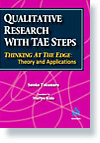検索結果一覧
QUALITATIVE RESEARCH WITH TAE STEPS THINKING AT THE EDGE:Theory and Applications


- 木田満里代[得丸智子著]



- A5

- 250

- 3,080円 (本体2,800円 )

- 2011年6月1日

- ISBN978-4-86327-145-6

- C3011

- 教育〈教育学〉

- This advocates efffectiveness of applying TAE
| 渓水社で購入する |
【品切】 |
|---|

- SECTION1:Applying TAE to Qualitative Research
Chapter 1:Qualitative Research and TAE
1. Qualitative Research and Creation of Meaning
1.1 Qualitative research is interested in meaning
1.2 Qualitative research is a field of research to create meaning
1.3 Qualitative Research and Sensitizing Concepts
2. Why TAE?
2.1 What is TAE?
2.2 Define a Felt Sense clearly
2.3 Steps are specific to visualize the process
2.4 Clearly linked to the underlying theory
2.5 What does TAE pursue?
2.6 TAE principles
2.7 Compatible with other methods
3. What TAE Can Do
3.1 To create meaning systematically from experience
3.2 Particulars participate in universals (IOFI)
3.3 Widely applicable from daily review to research
3.4 Applicable to the type of data that are mediated via felt sense
3.4.1 When working on one’s own experience as the subject matter
3.4.2 When working on another person’s experience
Chapter 2:TAE and Gendlin’s Theory of the Creation of Meaning
1. Moving back and forth between entitizing and universalization
2. Experiencing is always more complex than form
3. Functions of a felt sense
3.1 A felt sense calls forth symbols
3.2 A felt sense is progressing with selected symbols
3.3 Dealing with symbols operationally, separately from the felt sense
Chapter 3:Applying TAE to Qualitative Research
1. Overview of TAE STEPS
14 STEPS
Characteristics of the Three Parts
2. Before starting Part 1
3. Part 1
STEPS 1-5:SPEAKING FROM THE FELT SENSE
Step 1:Let a felt sense form
Step 2:Find what is more than logical in your felt sense
Step 3:Notice that you don’t mean the standard definitions of the words
Step 4:Write a sentence or fresh phrase to say what you wanted each keyword to mean
Step 5:Expand what you wanted each word to mean by writing fresh, linguistically unusual sentences
4. Part 1:Summary
5. Before Starting Part 2
6. Part 2
STEPS 6-9:FINDING PATTERNS FROM FACETS (INSTANCES)
Step 6:Collect Facets
Step 7:Allow the facets to contribute detailed structure
Step 8:Cross the facets
Step 9:Write freely
7. Part 2:Summary
8. Before Starting Part 3
9. Part 3
STEPS 10-14:BUILDING THEORY
Step 10:Choose terms and link them
Step 11:Inquire into the inherent relations between the terms
Step 12:Choose permanent terms and interlock them
Step 13:Apply your theory outside your field
Step 14:Expand and apply your theory in your field
10. Part 3:Summary
Chapter 4:Reading a Literary Work with TAE
1. Part 1
STEPS 1-5
2. Part 2
STEPS 6-8
STEP 9
3. Part 3
STEP 10
STEP 11
STEP 12:1st Half
STEP 12:2nd Half
STEP 13
STEP 14
SECTION2:Gendlin’s Theory on the Creation of Meaning in the Background of TAE
Chapter 5:Gendlin’s Theory of the Creation of Meaning
1. The body is a concrete mass in process
1.1 B-EN process
1.2 Occurring into implying
1.3 Implicit ‘type-a’ and first universals
2. Direct reference is minimal symbolization
2.1 Human beings can perceive experiencing through direct reference
2.2 Direct Reference
2.3 Felt Sense
2.4 Second universals (1) “as such”
3. Patterns are the most primitive symbols
3.1 Humans have the capacity to find patterns
3.2 Doubling
3.3 Separation of patterns
3.4 Patterns function by means of implicit intricacy
3.5 Second Universals:Pattern (2)
4. Language develops from Patterns
4.1 Mesh
4.2 Beginning of symbols
4.3 Three types of carrying-forward
4.4 Cluster and lateral crossing
4.5 Collective crossing and category
4.6 Collective crossing by using words
4.7 Third universals
5. Seven modes of functional relationship between felt sense and symbol
5.1 Direct Reference
5.2 Recognition, and Explication
5.3 Metaphor, and Comprehension
5.4 Relevance, and Circumlocution
5.5 The act of having a conversation
6. Creative Regress, and Direct Referent
6.1 Creative Regress
6.2 Versioning
6.3 Monad-Diafil Development
7. Responsive Order
Exercises
Exercise 1. Relaxing
Exercise 2. Straw Dance
Exercise 3. Expressing Yourself Using Colors
Exercise 4. Analogy
Exercise 5. Finding a Favorite Place
Exercise 6. Finding a Pattern from Fables and Crossing
Exercise 7. What is Important
Exercise 8. Working with a Short Story
Theory Columns
Column 1. Direct Reference and Creative Regress
Column 2. Creating a Likeness
Column 3. Constructing a common organization
Column 4. Constructing a logic
Notes
References
Appendix:TAE-based analysis of qualitative research data
Index



